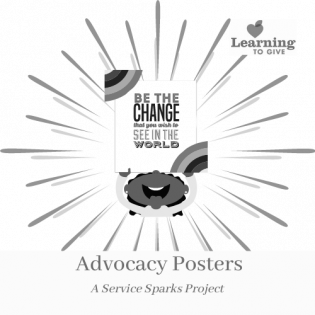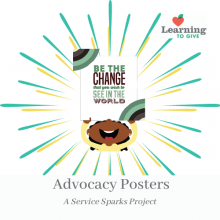Service Sparks: Advocacy Posters
Keywords:
Advocacy
Communication Skills
Justice
SimpleSafeService
Social Justice
Speaking and Listening
Symbols
Ignite meaningful action that lights up the world through "Service Sparks" youth projects! Listen carefully to the community or personal needs expressed by others. Focus on an issue you care about and make a poster to simply communicate a message you want others to hear. Images and words together can inform and persuade to make change.
SERVICE SPARKS
Ignite meaningful action that lights up the world through "Service Sparks" youth projects!
Posters are used to communicate messages through art and language. This activity involves learning about and discussing issues we care most about and then using advocacy and art to share our ideas with others.
- Take some time to speak with family members, friends, neighbors, and others about issues of concern. Make a list of the things that are currently causing people pain - in the country, in the community, or in your circle of friends and classmates. This may be related to social issues, injustice for a particular group, loneliness, or another idea. The History of U.S. Philanthropy timeline is full of stories of people taking action to make a better world.
- Choose one of the things on your list, look up facts from reliable sources, and discuss the issue with a friend or family member. Listen carefully to what people are saying. Really listening and being open to learning helps you understand what they feel and why and how they hurt. Listening is the first step in healing. It also helps you become aware of how you think and feel about important issues.
- Make a poster that you can display in a public place to inform and persuade others. When you make a poster, you are volunteering through advocacy. An advocate pleads the cause of another, defends or maintains a cause or proposal, or supports or promotes the interests of another.
- An effective poster has three parts: 1) Six or fewer words, 2) art made up of familiar symbols or iconography, and 3) a positive message. Look at the sample below of a poster by Favianna Rodriquez with all of these elements.
-
Using poster board and art supplies, design a poster that demonstrates your advocacy and follows the three elements of a strong poster.
- The words may be a statement, a list of related strong words, or a question.
- Familiar symbols help your viewers quickly understand your message: heart, sun, moon, hand, flower, butterfly, clothing style, tree. You can use your own artwork.
- Your message should state what you want to see - in positive language - not what you don't want to see. (i.e., "Eat Five Vegetables a Day!" not "Junk Food is Bad for You!")
- Talk about where your poster can be displayed. This may be in your window, at a local place, or on social media. Display your poster.
- Learn more with a Learning to Give lesson plan on Art as Advocacy.
Reflection: Where did you put your poster and why did you put it there? What was the response that you saw or heard?
Explore more Service Sparks activities.
Learning to Give ...
- educates youth about philanthropy, the civil society sector, and the importance of giving their time, talent and treasure for the common good (knowledge),
- equips youth by encouraging philanthropic behavior and experience (skills), and,
- empowers youth to take voluntary citizen action for the common good in their classrooms, lives and communities (behavior).


